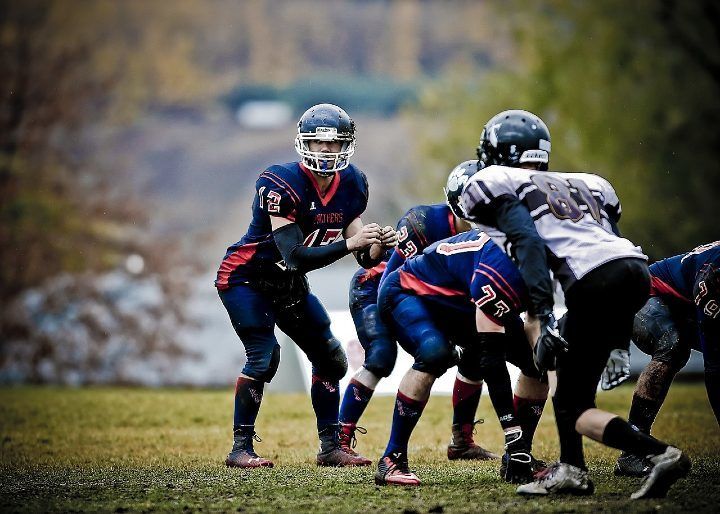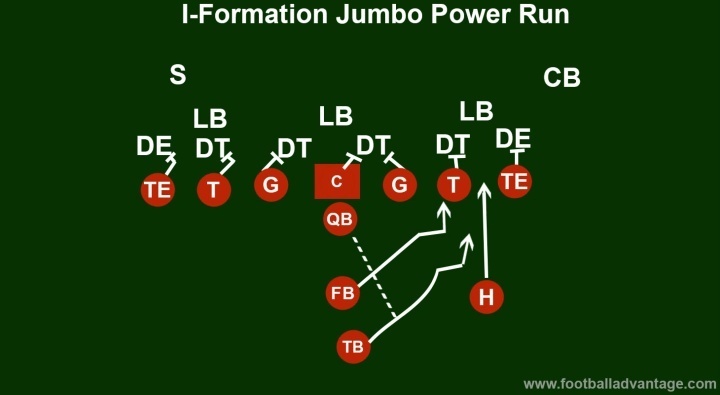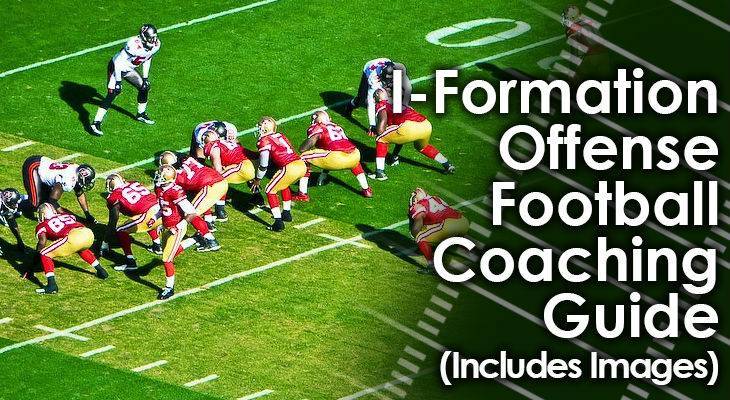The I-Formation Offense is a great offensive formation that has been, and still can be, used at just about any level of football.
It’s an offense that is designed to overpower the defense at the line of scrimmage by overloading “the box”.
Most of the time, an I-Formation offense will be deployed with a tailback and fullback, as well as at least one tight end.
This loads the line of scrimmage with extra blockers for the offense, giving them an advantage at the point of attack.
The formation also forces the defense to make adjustments to bring in extra guys on the line of scrimmage to counter the offense’s alignment, which could eventually open up some opportunities in the passing game.
While the I-Formation is often used by offenses that like to run “smash mouth” football right up the gut, as it were, the offense can also keep defenses honest with a flurry of passing plays and because there are a variety of players who will run passing routes out of the offense.
Who Should Use the I-Formation Offense?
Teams Who Like to Run - The I-Formation was designed as a power running offense. So those teams that have good run-blocking offensive linemen will do well to run the offense.
Teams Who Have More Traditional Personnel - To successfully run an I-Formation offense, a team will have to have a good tailback, fullback, and at least one tight end who can block.
Teams Who Can Deploy a Balanced Attack - The I-Formation is great for teams who like to have a nice balance of running and passing plays. The power run game can set up the play-action passing game quite nicely in an I-Formation offense. In fact, that’s what makes it so successful.
Teams Who Have Good Hands - One of the intricacies of the I-Formation is that the quarterback will throw the ball to not only his wide receivers and tight ends, but to both of the running backs as well. That’s why it’s important to have a lot of good pass catchers if you want to run an I-Formation.
Who Should Not Use the I-Formation Offense?
Teams Who Like to Change It Up - The I-Formation is a pretty basic offense, especially in terms of its alignment. If your team likes to deploy a lot of different looks and funky formations, then this is not the offense for you.
Teams Who Throw Downfield a Lot - While the I-Formation is a good offense for passing the football, it isn’t great for teams that throw the ball a majority of the time, especially if those passes are thrown deep often.
Teams Who Don’t Have a Good Fullback - The fullback may be the most important piece to an I-Formation offense. Not only will he be the lead blocker on almost every play, it’s important for the deception of the offense that he be able to carry the ball and catch the ball every once in a while, too.
I-Formation Offense Personnel
The base personnel will be roughly the same on every single play that’s run out of this offense.
That’s one of the ways that the offense will hide the plays it’s running.
While the below is a general guideline for the base personnel, some coaches will make slight alterations by adding another tight end to the formation and substituting out a wide receiver.
Here is the more traditional personnel in a I-Formation offense:
Backfield:
• Quarterback (QB)
• Tailback (TB)
• Fullback (FB)
Offensive Line:
• Center (C)
• Two Guards (G)
• Two Offensive Tackles (T)
• Tight End (TE)
Wide Receivers:
• Z Wide Receiver (Z)
• X Wide Receiver (X)

I-Formation Offense Formation
The I-Formation was named that because of how the backs are lined up directly behind the quarterback.
This will be the case on just about every play that’s run out of the I-Formation, although the fullback may split out a little wider in what’s known as an off-set I-Formation.
The standard formation for all I-Formation plays are:
Center (C): Starts over the ball in his normal position
Guards (G): Both start in their normal position, on either side of the center
Offensive Tackles (T): Both start in their normal position, on the outside of the guards
Tight End (TE): Starts outside the offensive tackle on either side of the field, depending on the particular play call
Y Wide Receiver (Y): Starts lined up wide near the sideline at the line of scrimmage, on the opposite side of the center from the tight end
Z Wide Receiver (Z): Starts lined up wide near the sideline off the line of scrimmage, on the same side of the center as the tight end
Quarterback (QB): Starts lined up under center to take the snap
Fullback (FB): Lines up directly behind the quarterback (or slightly to his right or left) about three yards back.
Tailback (TB): Lines up directly behind the quarterback, about five yards back. He will be directly behind the fullback on some plays, or have the fullback to his left or right if it’s an off-set I-Formation play.
2 I-Formation Offense Plays
In order to truly see the how the I-Formation can be run in all its glory, we’ll need to take a look at both a passing play and a running play.
First, we’ll take a look at a passing play that’s run out of a more traditional alignment with an off-set I-Formation.
Then, we’ll take a look at a running play that’s run out of a Jumbo package, with an extra tight end on the field.
I-Formation Option Flats Pass

This play will utilize one tight end and two wide receivers, with an off-set I-Formation in the backfield.
The idea of this play is to flood the field with passing options for the quarterback, as five players will be running passing routes.
This makes it especially difficult for defenders to pick up all the proper coverage assignments.
Here is the breakdown of the personnel and the responsibility of each player:
Offensive Line: The center, both guards and both offensive tackles will line up at their normal positions along the line of scrimmage. At the snap of the ball, the center and tackles will pass block straight ahead. The guards will take a slight step back, since no defenders will be lined up directly across from them, and they’ll take a peak to the outside to see if they need to pick up any blitzing players.
Tight End: Will line up on the right side of the field, outside the offensive tackle. At the snap, he will release and run a deep corner route, hopefully taking the strong safety with him.
Wide Z Receiver: Will line up on the same side of the field as the tight end, slightly off the line of scrimmage. At the snap, he will run an option route about 10 yards off the line of scrimmage. He will run straight ahead, then stop at about 10 yards and either choose to run an out route or an in route, depending on what he feels is better based on the coverage.
Y Wide Receiver: Will line up on the weak side of the field at the line of scrimmage out wide. At the snap, the Y will run a fade route deep to his side of the field, hopefully taking the cornerback with him and possibly even attracting attention from the free safety.
Fullback: Will line up slightly to the quarterback’s left, almost directly behind the offensive guard. He will run a flat route to the weak side of the field.
Tailback: Will line up directly behind the quarterback, about five yards deep. He will run a swing route to the strong side of the field, serving as the quarterback’s safety valve if no one else is open.
Quarterback: Will line up under center. At the snap, he’ll drop back about five to seven yards and go through his passing progression, looking first for the deeper routes, then checking down to the shorter routes and finally the tailback out of the backfield.
I-Formation Jumbo Power Run

The I-Formation is also often used in short-yardage situations where the offense just needs to gain a yard or two to get a first down.
In these situations, coaches will often call in a Jumbo package.
This play will use a basic I-Formation, but then remove both wide receivers from the field, substituting them instead with an extra tight end at the line of scrimmage and an H-Back in the backfield as well.
The idea here is to overload the line of scrimmage with blockers to open up a hole for the tailback to run through.
Here is the breakdown of the personnel and the responsibility of each player:
Center: Will line up in his normal position and will be responsible for blocking the defensive tackle lined up over his right shoulder.
Weak-side Guard: Will line up in his normal position to the left of the Center and will be responsible for blocking the defensive tackle lined up over his right shoulder.
Weak-side Offensive Tackle: Will line up to the left of the Guard and will be responsible for blocking the defensive tackle lined up directly over top him. He will be asked to hook in and block the tackle toward the weak side of the field.
Weak-side Tight End: Will line up outside the Offensive Tackle and will be responsible for blocking the defensive end lined up over him. He will be asked to hook in and block the end toward the weak side of the field.
Strong-side Guard: Will line up in his normal position to the Center’s right. He will be asked to block the defensive tackle lined up over his left shoulder, and he will get help doing so from the Center.
Strong-side Offensive Tackle: Will line up to the outside of the Guard and will be responsible for blocking the defensive tackle lined up directly over him. He will try to block the tackle toward the middle of the field to open up running room through the C gap.
Strong-side Tight End: Will line up outside the Offensive Tackle and will be responsible for blocking the defensive end lined up opposite him. He will be asked to block the end toward the sideline to open up the C gap.
Fullback: Will line up directly behind the quarterback, about two-three yards back. He will run directly behind the Offensive Tackle on the strong side of the field, acting as the lead blocker for the tailback and picking up the first defensive threat that comes his way.
H-Back: Will line up a few yards to the right of the Fullback, to the outside foot of the Offensive Tackle, at the same depth as the Fullback. At the snap, he will run straight ahead through the C gap and picking up the first defensive threat that comes his way.
Quarterback: Will line up directly under center. At the snap, he will take a slight diagonal route toward the strong side of the field to hand the ball off to the Tailback.
Tailback: Will line up directly behind the Fullback, about two-three yards back. At the snap, he will take a diagonal route toward the strong side of the field and take the handoff from the quarterback. He will use the Fullback and the H-Back as lead blockers and run toward the C gap. The Tailback will make adjustments to where he runs based on where he sees the hole(s) open up along the line of scrimmage.
Conclusion
As you can see, the I-Formation is an offense that can be used by just about any team at just about any level of football.
That’s because it is extremely simple to understand and to implement, and it doesn’t require any crazy plays/responsibilities or intricate personnel formations.
Teams that have a nice balance of running and passing plays, and that can play smash mouth running football at times, will do very well with an I-Formation.
Conversely, teams that like to spread the field and throw the ball a lot might want to take a look at a different option for running their offense.

